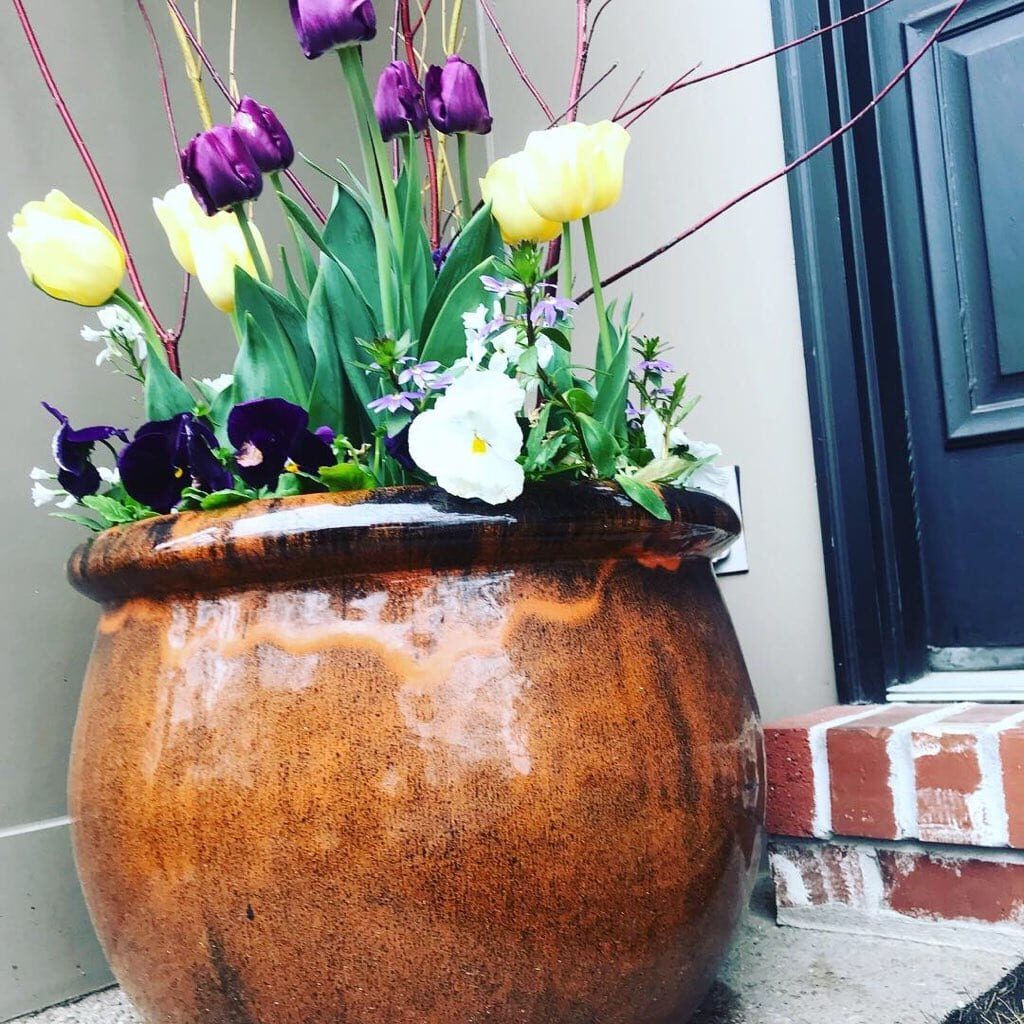Landscape Maintenance Advice From Professional Horticulturists
Seasonal Tips
Gardens of Grace offers a monthly guide to caring for your landscape all year long.
January
The catch phrase for this month is “go with the flow.” In other words, try to minimize physical contact. Don’t walk across your grass. Don’t walk in your beds. Don’t touch dormant plant material (trees would be the exception).
Instead, plan for spring planting. At Gardens of Grace we review the industry’s newest trends and plants by attending seminars and catching up on the many magazines that seem to pile up during the busy planting season. Organized clients like to get a head start on spring planting, and for those clients we begin the design process. If it should snow, please spend time enjoying the scene. We plan our gardens to look great in all seasons.

February
Most days are cold, but we begin to see glimpses of the spring season that lies ahead. So it is no surprise that we start to make definite plans for the coming months. Many clients think about their landscapes throughout the winter. We encourage feedback and comments, which make February planning meetings even more productive. In addition, the nurseries are organizing for their spring shipments and we communicate constantly to ensure the best quality plants for our clients.
While it is still too early to disturb existing plant material, we remove the inevitable messes that have accumulated during the winter. Therefore, we blow off decks and patios, pick up trash and clean dead leaves from corners.

March
This month can be tricky. Too much plant work too soon can lead to dead plants if we get a late freeze. Yet, people are anxious to get their gardens prepared. We begin the process of removing dead leaves from the base of plants, working carefully not to expose too much new growth. We apply the first application of a preemerge herbicide to prevent annual weeds from germinating.
One way to enjoy March is to plant bulbs like tulips, daffodils and hyacinth in the fall to bloom through March and April. Mini gardens can be planted in pots using a combination of bulbs and cool season annuals like pansies. Pansies planted in November may endure until May, growing larger than those planted in the spring.
April
April through June are the busiest months of the horticultural industry. Nurseries receive plant shipments virtually every day. If the weather cooperates, landscapes are installed at a quick pace. Transformations seem to occur over night. Much of our scheduling has occurred and we have to work hard to stay on schedule-dodging weather conditions and unexpected delays in plant shipments.
In addition to planting new landscapes, existing landscapes need work as well. The last of the winter debris is removed. Many fall blooming shrubs such as butterfly bushes and roses are pruned. Most plants are fertilized with a balanced all-purpose granular fertilizer. As new growth emerges, plants are pruned to desired shapes and sizes. Perennials may be divided to maintain vigor or increase garden size. Pots are cleaned and prepared for planting, some are planted at this time.
May
May continues in much the same way as April, except more so. Spring blooming shrubs and most evergreens are pruned as their flowers fade. We prune at the base of the plant to improve vigor and regulate size. Tip pruning controls shape and size. Most plants need some of both. We rarely use electric hedge clippers - it is not the best way to prune most plants.
We've found that it is better to purchase annuals as larger plants than to buy smaller and nurse along. Larger annuals seem to establish quicker. Also, due to variable weather in our area, smaller plants have a difficult time in the ground. Nurseries are better able to provide proper protection during poor weather. Many like to add fresh mulch after planting annuals. Spread to a thickness of 2-3”total (if there is mulch from the previous year add that depth to the total). Make sure mulch isn't placed over the base of plants or along the bark of trees. “Coning” of mulch around trees can contribute to a weak root system that could eventually kill the tree.

June
At Gardens of Grace, we plan to have most plants in the ground by the end of the month. Once we experience extremely hot temperatures, we evaluate whether we might improve plant viability by waiting until fall. The decision is made based upon duration of heat, type of plant and nursery care. It is often times made on a day to day, plant by plant basis.
In addition, weeds begin to increase during this month. Perennial weeds that can’t be prevented via preemerge herbicide are either pulled or treated with herbicide. Good weed management is about staying ahead of the game with an aggressive strategy of elimination and prevention.
Shrub roses are deadheaded and more fertilizer is applied for another flush of blooms.

July
The normally hot weather this month makes proper watering a top priority. In general, established plants will need about 1-2 inches a week. Continue with weed management. Deadheading will increase blooming for annuals and perennials.
August
August is the month of extra weed control. Weeds must not be allowed to go to seed or spread. Herbicide is sprayed on persistent, deep rooted weeds such as poison ivy. This time of year is not the best for pruning because we do not want to expose new growth to the sun and heat. If the area has not received a substantial amount of rain, supplemental watering will be necessary. Continue with the watering schedule from July.
We plan for fall landscape planting. Fall is the best time to plant a garden and many clients will proceed with additional phases of their landscape plans from spring. The new beds are normally prepped by laying compost and top soil on newspaper and allowing to “rest” until the cooler weather in September allows for planting. In addition, this is a good time of year for stone work, such as walkways, walls and borders.
September
September is the perfect month to plant and divide. As much landscape activity occurs between now and Thanksgiving as in the spring. This is for a very good reason. As the air cools through the fall, the ground stays warm. This promotes root development. Strong root development is the key to a healthy garden. If you are planting a garden this fall, please refer to our ‘Helping Hand’ page for further tips to strengthen your garden.
For maintenance, browning foliage of spring and summer perennials is removed to keep the garden fresh and free from disease. Shrub roses are deadheaded and fertilized for the last time of the season. The last pruning of the season is done on shrubs so that tender, new growth will have time to harden before winter.

October
October is a fun and festive month. Many people will decorate their exteriors for the fall holidays of Halloween and Thanksgiving. We change pots to reflect the new season-removing spent summer flowers and replacing with mums, grasses and pansies. This continues to be a great month for planting. Generally, we start the process of preparing landscapes for the upcoming winter season by continuing to prune brown foliage of perennials. Some clients will start on leaf removal (depending upon the types of trees and the amount of rainfall in their area).

November
We plan for planting until the middle of this month. Many trees are delivered to the nurseries and those are planted into December or until the ground freezes. For most of our clients, this will be the last visit until February of next year. This means we have to prune remaining perennials to within inches of the ground (sometimes we leave seed heads for birds to eat). Leaves are blown away. Exposed soil is covered with a layer of mulch. Spring blooming bulbs are planted. Evergreen plants must be well hydrated to thrive during the winter. Therefore, we check for soil moisture and water if necessary. Pots are emptied, cleaned and stored for the winter, unless winter decorating is done.
December
Depending upon the weather, some leaves may still have to be removed this month. In addition, we help many clients prepare their homes for Christmas. Pots are decorated on porches and decks. Swags and wreathes of pine and spruce are hung from doorways and balconies. We incorporate and blend the outdoor décor with the indoor using ribbons, ornaments and fabrics.

Gardens of Grace provides the St. Louis area with a broad-range of Landscaping Services.

